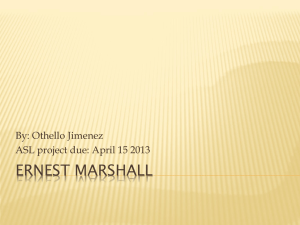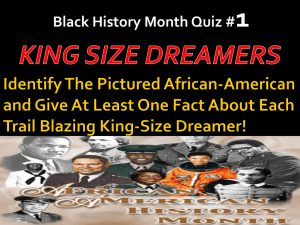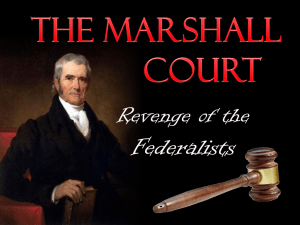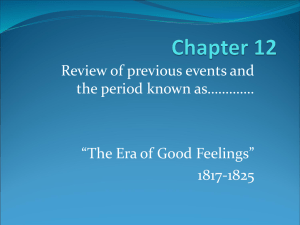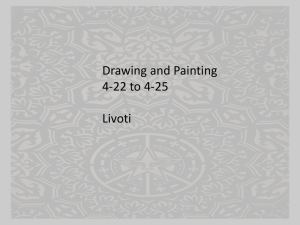Lessons in Art Appreciation and Criticism for Grades 6-8
advertisement
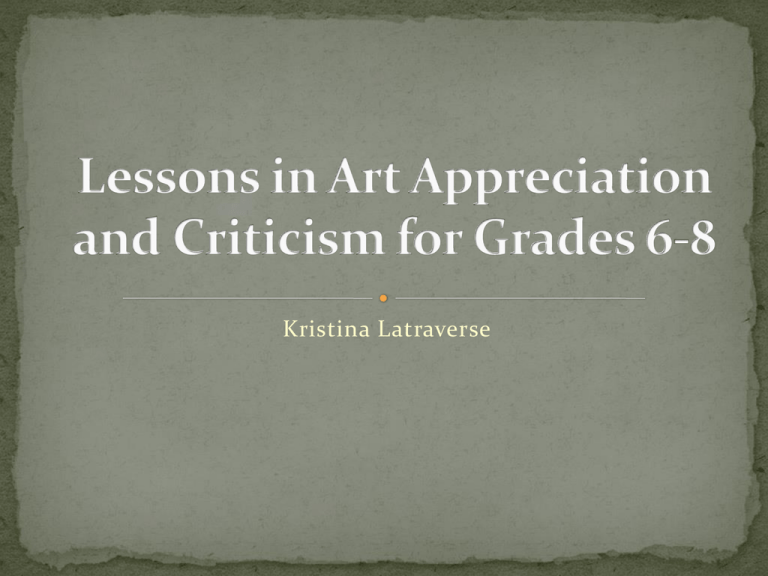
Kristina Latraverse Objective: Students will be introduced to the Feldman model of art criticism and learn how to describe a painting. Students will learn the definitions of power, audience and portraiture by studying the works of Kehinde Wiley and referenced historical works. NSSS VA.68.C.3 The processes of critiquing works of art lead to development of critical-thinking skills transferable to other contexts. VA.68.H.2 The arts reflect and document cultural trends and historical events, and help explain how new directions in the arts have emerged. Procedure The history of portraiture will be explained and the historical works of Frans Hals will be shown as an example. Students will be introduced to the works of Kehinde Wiley, a portrait artist, who paints portraits of people in positions of physical power who would ordinary not be painted in a portrait. Pre-Planning Students will begin by answering a pre-planning question in their sketchbook Question: What is the difference between a portrait and a “selfie”? Procedure Students will work in groups and use technology (smart phones and computers) to write down the definition and examples of portraiture, audience, and power. Table 1 &2: Portraiture: A representation of a particular individual Table 3& 4: Audience: the group of spectators at a public event; listeners or viewers collectively, as in attendance at a theater or concert Table 5 & 6: Power: the possession of control or command over others; authority; ascendancy Table 7 & 8: Write your own definition of a “selfie.” Students will be shown a video of Kehinde Wiley where he discusses his artistic process and how he selects his models Video: http://www.youtube.com/watch?v=Nq8Yr-Se7mc Each group will present their definitions and examples and relate it to the work of Kehinde Wiley as shown in his video. Each table will be given a large photograph/image of a Wiley portrait. Working in cooperative learning groups students will make a list of “what they see” in a work by Wiley. A minimum of twenty observations should be listed. Working in the same groups, students will repeat the process of describing work but this time look at a historical work which Wiley used as reference. Students will compare and contrast Wiley’s work with the historical portraits he modeled his work after. Students will create a side-by-side list of the descriptions of each and a list of the similarities and difference. Reflection & Assessment • Students will complete this lesson by answering a reflective question in their sketchbook. Question: How did each artist convey power in their portrait? Statement of Origin This lesson resulted from the reading of Olivia Gude’s, Principles of Possibility: Considerations for a 21st Century Art & Culture Curriculum. Gude highlights the importance of investigating community themes in art education because it teaches shared social experiences (Gude, 2007). Using elements and prompts that are generational provide rich source materials and excellent opportunities for peer discussion. In this lesson students are given an opportunity to discuss the social role of power, question who has it and identify different kinds of power. Tackling social issues activates higher levels of thinking and forces students to question themes and social norms that they may have not previously questioned. Community themes also provide a unique opportunity to reach beyond the school and extend projects into the community. Objective: This lesson is designed to further the student’s art criticism and appreciation knowledge. Students will use the first step of the Feldman model, to describe the work of Frank Romero. Students will learn how color plays a role in conveying emotion in a work. NSSS VA.68.C.3 The processes of critiquing works of art lead to development of critical-thinking skills transferable to other contexts. VA.68.H.2 The arts reflect and document cultural trends and historical events, and help explain how new directions in the arts have emerged. Students select one of the two works. Procedure Students will be introduced to the works of Frank Romero, a Los Angeles based artists who whose highly charged works bring important cultural issues to lights. Students will be introduced to color theory and use it as part of the descriptive process of art criticism. Preplanning Students will begin by answering a pre-planning question in their sketchbook Question: What color would be used to convey anger? What color would be used to convey love? A color wheel will be placed on the document camera and students will raise their hand and say an emotion that goes with each color. Using colored pencils students will make a color swatch of each color and list the emotions that they express. Blue: Peace, tranquility, cold, calm, stability, harmony, unity, trust, truth, confidence, conservatism, security, cleanliness, order, loyalty, sky, water, technology, depression, appetite suppressant Reds: Excitement, energy, passion, love, desire, speed, strength, power, heat, aggression, danger, fire, blood, war, violence, all things intense and passionate, Pink: caring, tenderness, calm, love Yellow: joy, happiness, betrayal, optimism, idealism, imagination, hope, sunshine, summer, gold, philosophy, dishonesty, cowardice, jealousy Orange: Energy, balance, enthusiasm, warmth, vibrant, expansive, flamboyant, demanding of attention. Green: Nature, environment, healthy, good luck, renewal, youth, spring, generosity, fertility, jealousy, inexperience, envy, misfortune, vigor. Brown: Earth, stability, hearth, home, outdoors, reliability, comfort, endurance Planning Students will be introduced to the works of Frank Romero. Student will be shown two images. Students will watch a short video in which Frank Romero discusses his work and talks about his artistic process. This video helps students gain a greater understanding of his works. Video: http://www.youtube.com/watch?v=zyOE_UmsL6w Each student will select one of two works by artist Frank Romero. Using knowledge gained in the previous lesson students will make a list, describing the painting they selected. Students must also list colors used and the emotions each color represents in the work. Students will turn a list of 25 descriptions and 5 colors used and their symbols. Assessment Students will be graded on class participation and completion of the assignment. Statement of Origin This lesson was inspired by the Feldman model of art appreciation and criticism. Description is the first step of the process and I feel that it is one of the most important. Teaching students how to describe a work increases their visual literacy and reinforces art terminology. Having the ability to actively look at a work enables them to gain the tools to more critically view the world around them. Additionally, describing and understanding multiculturalism is an important facet to both education and the art world (Feldman, 1994). Objective: Students will access prior knowledge gained in previous lessons and build upon it to further their understanding of the art criticism process. Students will be able to define and explain balance, harmony and color. Students will identify and describe the works of Kerry James Marshall and learn how to analysis them using the Feldman model. NGSSS: VA.68.C.3 The processes of critiquing works of art lead to development of critical-thinking skills transferable to other contexts. VA.68.C.1 Cognition and reflection are required to appreciate, interpret, and create with artistic intent. VA.68.H.2 The arts reflect and document cultural trends and historical events, and help explain how new directions in the arts have emerged. Procedure Students will be introduced to the works of Kerry James Marshall. Marshall’s work is drawn from African American popular culture and visually engages the viewer through his use of culturally charged subject matter, vivid colors and narrative depictions. Students will be shown his work and asked to respond to it. Pre-Planning Students will begin by answering a pre-planning question in their sketchbook Question: Why is balance important in a piece of art? As a group, a class discussion will be lead showing how Marshall uses balance, harmony and color in his work. Students will write down their own definition of balance, harmony and color. Students will watch a short video about Kerry James Marshall and the theme of identity. http://www.pbs.org/art21/artists/kerry-james-marshall Students will select one of three works by Marshall to complete their assignment. Planning Students will begin as they have in previous lesson by making a list, describing the work which they selected. Each student should list 25 descriptive phrases about the work. Students should list 5-8 colors Marshall uses and what it symbolizes. Students should use their sketchbook for reference. Students will write down how Marshall uses harmony and balance in his piece. Application Students will write their first critic using a two paragraph model. The first paragraph should focus on description, the second on color, balance and harmony. Assessment Students will grade their own work based on a rubric given prior to the lesson. The student’s completed rubric will be stapled to their writing. Using the same rubric the teacher will grade their writing and give feedback. Students will… 1. Describe 2. List 3. Harmony 4. Balance 5. Write Statement of Origin The works of Kerry James Marshall were first introduced to me while taking ARE 4352, Art in Secondary School, at the University of Central Florida. This lesson was created as a result of reading Feldman’s, Practical Art Appreciation and Criticism and viewing the works of Marshall. Marshall was selected for this lesson because his works are visually engaging and tell a narrative story that students can relate to. Marshall’s works posses both strong cultural content and formal components which make them ideal for teaching the importance of both. Objective: Students will learn and understand the role of media in our lives. Students will begin to understand the power of advertising and how it should be critically evaluated not simply accepted. The Feldman model will be used to analyze advertisements, teaching students that criticism and critical observing is not limited to works of art. NSSS VA.68.C.3 The processes of critiquing works of art lead to development of critical-thinking skills transferable to other contexts. Can you trust everything you see in print or read online? Pre-Planning Students will begin by answering a pre-planning question in their sketchbook Question: What is the purpose of advertising? Discussion As a class, students will discuss the sketchbook question. The answers will be written on the board/document camera. As a class, they will create one general definition of advertising. The question, “Is all advertising truthful?” will be asked. Students will be shown the two advertisements about smoking. One at a time. In their sketchbook students will repeat the procedures from the previous lessons. Write down 25 descriptive phrases describing ad #1 Write what colors are used and what they symbolize. As a class we will discuss their descriptive phrases/color symbolism and create a “word web” on the document camera. The second ad will be displayed; we will compare and contrast the two advertisements which highlights: Differences One ad is a public service announcement, one is selling a product One is a graphic while the other is a photograph Colors Similarities They are both about teeth/dentists and smoking Both use similarly aged people In a group discussion will be held discussing the two ads and the message each is conveying. Assignment Students will work in cooperative learning groups and go through magazine ads and write a critic about the advertisement (2 paragraphs).Each seat will have an individual assignment to ensure proper distribution of work. Seat 1: Descriptive Writer Seat 2: Color Writer Seat 3: Paragraph Writer Seat 4: “Questions to Ask”, writer Assessment Students will turn in their ad and their critique stapled together. Statement of Origin In today’s’ face paced, technology driven society everyone in bombarded with a plethora of advertisements, some we are aware of, others are subconscious. It is important to make students aware of the advertisements and their purpose. These two ad were selected because they show how advertising can be deceptive and how our society changes. These ads show students the importance of questioning and critically thinking about what they see. The continuous use of the Feldman model lays a foundation for looking not just at art, but the world around them. Through the repeated use of the Feldman model, critically looking at images and advertisements should become second nature, creating students with greater visual literacy.


